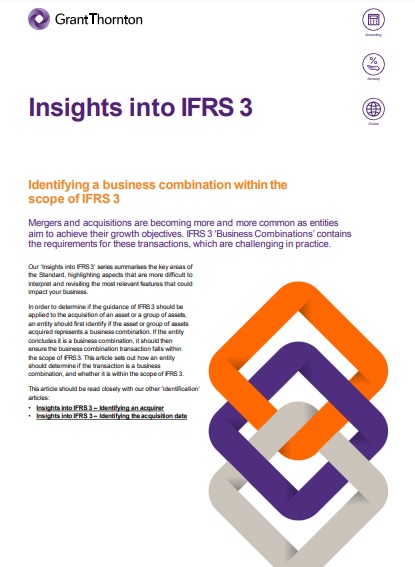-
Business Risk Service
Organisations must understand and manage risk and seek an appropriate balance between risk and opportunities.
-
Transaction Advisory, M& A, Business Consultancy
Transaction Advisory, M& A, Business Consultancy
-
IT Advisory
IT Advisory
-
Business Process Solutions
Business Process Solutions
-
Managing the VAT Audit
Managing the VAT Audit
-
Transfer Pricing
Global transfer pricing is all about understanding your business and the value drivers of your industry in an ever-changing environment.
Mergers and acquisitions are becoming more and more common as entities aim to achieve their growth objectives. IFRS 3 ‘Business Combinations’ contains the requirements for these transactions, which are challenging in practice.
In order to determine if the guidance of IFRS 3 should be applied to the acquisition of an asset or a group of assets, an entity should first identify if the asset or group of assets acquired represents a business combination. If the entity concludes it is a business combination, it should then ensure the business combination transaction falls within the scope of IFRS 3. This article sets out how an entity should determine if the transaction is a business combination, and whether it is within the scope of IFRS 3.
Identifying a business combination
IFRS 3 refers to a ‘business combination’ rather than more commonly used phrases such as takeover, acquisition or merger because the objective is to encompass all the transactions in which an acquirer obtains control over an acquiree no matter how the transaction is structured. A business combination is defined as a transaction or other event in which an acquirer (an investor entity) obtains control of one or more businesses.
An entity’s purchase of a controlling interest in another unrelated operating entity will usually be a business combination (see Example 1 on page 3 of the pdf). However, a business combination may be structured, and an entity may obtain control of that structure, in a variety of ways.
Is the investee a 'business'?
IFRS 3 requires the entity determine whether assets acquired and any liabilities assumed constitute a business. If the assets and liabilities are not considered to be a business, then the transaction should be accounted for as an asset acquisition.
IFRS 3 has detailed guidance on the definition of a business and this guidance has been considered in our separate article ‘Insights into IFRS 3 – Definition of a business (Amendments to IFRS 3)’. This publication presents only the guidance on the new definition of a business that was issued in October 2018, which should be applied to business combinations for which the acquisition date is on or after the beginning of the first annual reporting period beginning on or after 1 January 2020 and to asset acquisitions that occur on or after the beginning of that period.
Business combination accounting does not apply to the acquisition of an asset or asset group that does not constitute a business. The distinction between a business combination and an asset acquisition is important as the accounting for an asset purchase differs from business combination accounting in several key respects.
Has control been obtained?
A business combination involves an entity obtaining control over one or more businesses (this entity is known as ‘the acquirer’). IFRS 10 ‘Consolidated Financial Statements’ and IFRS 3 provide guidance to determine whether an entity has obtained control.
In most cases, control of an investee is obtained through holding the majority of voting rights. Therefore control is normally obtained through ownership of a majority of the shares that confer voting rights (or through obtaining additional voting rights resulting in majority ownership if some were already held). In transactions where an acquired business is not a separate legal entity (a trade and assets deal), control typically arises through ownership of those assets.
However, control can also be obtained through various other transactions and arrangements – some of which require careful analysis and judgement. The definition of control and relevant guidance issued by both the IASB and IFRIC should then be considered. As well as assessing whether control is obtained, this guidance is also relevant in addressing the related questions of when control transfers and which entity obtains control.
The identification of an acquirer is discussed in more detail in a separate article. Refer to ‘Insights into IFRS 3 – Identifying the acquirer’.
Is the business combination within the scope of IFRS 3?
IFRS 3 applies to all business combinations identified as such under IFRS 3 with the following three exceptions:
- the formation of a joint arrangement in the financial statements of the joint arrangement itself
- a combination of entities or businesses under common control (referred to as common control combinations)
- the acquisition by an investment entity, as defined in IFRS 10, of an investment in a subsidiary that is required to be measured at fair value through profit or loss (without exception).
Further information on these three areas is outlined in the document.
What's next for IFRS 3?
At the time of writing the International Accounting Standards Board (IASB) is conducting a research project on business combinations under common control. The IASB has acknowledged that the absence of specific requirements has led to diversity in practice and has published a discussion paper in November 2020. The IASB is seeking views on the paper before 1 September 2021 and we will be submitting our views. For more details of the project and its next steps, click here.
How we can help
We hope you find the information in this article helpful in giving you some insight into IFRS 3. If you would like to discuss any of the points raised, download our publication and speak to our Grant Thornton Bahrain contacts.

